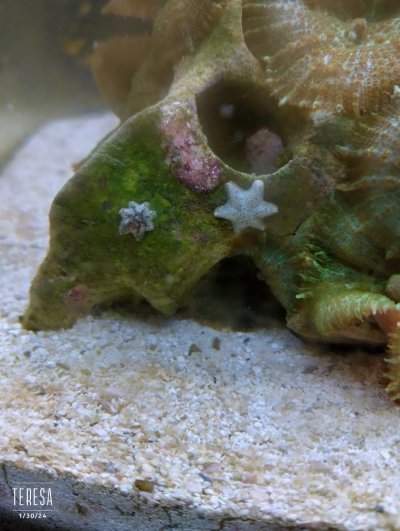Navigation
Install the app
How to install the app on iOS
Follow along with the video below to see how to install our site as a web app on your home screen.
Note: This feature may not be available in some browsers.
More options
You are using an out of date browser. It may not display this or other websites correctly.
You should upgrade or use an alternative browser.
You should upgrade or use an alternative browser.
Stars?
- Thread starter teresawm
- Start date
- Tagged users None
Asterina starfish
- Joined
- Jun 13, 2019
- Messages
- 276
- Reaction score
- 127
Asterina's; I have heard some people keep them, but I always pull them if I see them in my tank especially if they have spots.
No spots one is all white and one is gray. Why don't you like the spotted onesAsterina's; I have heard some people keep them, but I always pull them if I see them in my tank especially if they have spots.
Good or badAsterina starfish
Some like to keep them, some dont. If I see them I just pull them out.Good or bad
- Joined
- Jun 13, 2019
- Messages
- 276
- Reaction score
- 127
From what was told to me when I had this same issue a few years ago, was that any ones that had spots could eat corals. I'm not sure how true that is, but I am not taking any risks just for minor help with CUC.No spots one is all white and one is gray. Why don't you like the spotted ones
Some general info and some info specifically on if they eat corals or not:
Both Aquilonastra and Asterina are genuses of small starfish in the Asterinidae family, but Asterina stars are typically predatory and (at least primarily) reproduce sexually while Aquilonastra stars are typically not predatory and tend to reproduce more through asexual means (they’re fissiparous, so they reproduce through fission - basically they either split in half or drop a leg, and then the splits halves or the main body and the dropped leg then regenerate into fully-formed individual starfish). The fissiparous reproduction is why their populations tend to reach extreme levels in our aquariums; they can reproduce sexually as well (though I’ve never heard of them spawning in our tanks - it might happen unseen), but because they spawn rather than laying eggs or birthing live young, the spawn would likely be wiped out in a normal reef tank (pelagic larvae tend not to do very well in our tanks due to predation, removal by equipment and water changes, lack of available proper foods, etc.).
Personally, I like them, but they do tend to reproduce very quickly.
I've heard some species eat corals and others don't - I've seen convincing evidence for one species (a very darkly colored one), and one piece of somewhat convincing evidence for one different species, but the vast majority of these guys seem to be at least mostly safe.
With regards to whether or not the average "Asterina" (technically Aquilonastra - Asterina is a separate genus within the Asterinidae family) eat corals, it might be a species specific thing, it might be a you have way too many starfish so they're out of other food options thing, it might be they're eating the slime coat/mucus on the coral rather than the coral itself (see below), or they might just opportunistically eat unhealthy corals. Based on how starfish eat, it seems plausible to me that it may also be coincidental (i.e. the star goes to eat something off the coral and the coral just happens to be one that is able to be negatively effected by the star's everted stomach). Regardless, Zoas are just about the only coral I've heard about regular "Asterina" stars potentially going after with any sort of frequency.
A quote I like to refer to for this:
Timfish said:
It's an Aquilonastra spp. starfish and is a great scavenger. I see them with anywhere from 4 to 12 legs. The whole discusion around them seems to me excellent examples of misidentification, mistaken behaviour and assumed causality based just on heresay without looking at the research. Asterina spp starfish are preditary but only reproduce sexually and are shortlived so while it's possible some might get into a tank even if it did happen it's not going to be around long. Aquilonastra are one of the uncommon species that reproduce fissiparous or by splitting so are easy to identify by the different sized legs regrown after splitting. They perform an important function not only feeding off algae films but also feeding off microbial films including those on corals (at least ones that don't sting). FYI the mucus coating on corals ages and corals have to periodicely shed it to renew it and maintian healthy microbial processes (Ref 1, Ref 2). If Aquilonastra are feeding on zoas or softies I'll argue they are either benign or even beneficial as they may be reducing the unhealthy older mucus which can be full of unhealthy microbes which the animal is trying to get rid of and are far more likely to be the actual problem.
Here's an example, this Toadstool is doing one of it's periodic sheddings. The Aquilonastra have been in this system for years but only climb onto the Toadstool when it's shedding. In the first picture you can see the old mucus film, Aquilonastra starfish and areas they have cleaned off. The second picture shows the Toadstool a week later.


kevgib67
7500 Club Member
View Badges
Hospitality Award
Midwest Reefer
Rock Pool Reef Keepers
Ohio Reefer
My Tank Thread
My Aquarium Showcase
I pluck as many out as I can but still can’t keep up.
Similar threads
- Replies
- 12
- Views
- 193
- Replies
- 18
- Views
- 540
- Replies
- 11
- Views
- 247
















